Marshalls 2009
At this time of year, a new brochure seems to come along almost every day. Not all of them can be reviewed on the website: some don't have sufficient content; others are exactly the same as the previous edition except for the year having been updated; and some are too local to be of interest anywhere more than 10 miles from their home. No-one could ever think that Marshalls would fall into any of the above categories, but for some reason, there seems not to be a review of their 2008 offering.
There's a small number of brochures that are likely to be reviewed each year, and so when a new edition is published and I've had a chance to leaf my way through it for a day or two, the next job is to read what was written about the previous edition to avoid repeating what has gone before. No Marshalls 2008! Where is it? I've no notes documenting why 2008 was overlooked; there's no half-finished articles buried in the wrong folder on the hard drive, so I've no idea what happened, and yes: I have checked to make sure that I did actually get a copy last winter!
Ah well, it's too late now. We might as well have a look at the 2009 oeuvre...
The unsurprising news is that it is in the very same style as the last seven outings. A4 size, bound on the spine, printed on lightweight glossy paper, running to a healthy 172 pages, and this year's cover star is the Haworth Moor Antique Silver Limestone, the familiar Kota Blue run through the brushes of an antiquing machine to give it a very attractive softly weathered appearance with the hint of a sheen when first unpacked.
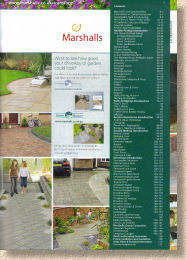
The contents of those 172 pages are somehow squeezed onto a skyscraper shaped box taking up just one-third of page 3 while blurb about the Visualiser Tool are lavished with a comparatively generous two-thirds. And no indication of which, if any, of the products crammed into that anorexic column, are new. Like most people, I do pore over almost every page, but when a new brochure arrives, I can't help turning first to the newbies, and with no clues as to what might be new, my fun is somewhat spoiled. Admittedly, all but one of the debutantes were trailed in a press release back in October , but that was four months ago - I've slept since then and need reminding what to look for!
The stinginess shown towards the contents is made all the worse by the following 18 pages of waffle. Perhaps 'waffle' is a touch unfair; after all, sustainability, carbon footprints and the involvement with the Chelsea Flower Show are important topics, but how many people will actually read those pages? And two pages wasted on a garden makeover for a chuffing zelebrity? Take it away before it hurts my eyes!
And more bloody lifestyle labels: "Designer", "Rustic", "Exotic", "Traditional" - I know it's an annual moan, but how many of us actually want to read this sort of thing? I've watched clients skim past these pages when given a brochure to explore. In our time-hungry society, they tend not to waste time reading about 'transformations'. I know from talking with contractors that it's of little value to them. Like me, they skip through to the meat, the actual products, and that could be a mistake in this issue because there is actually a useful piece that outlines the new rules for front garden paving in England. I'm not sure why, but there's no mention of the fact that the rules are only applicable to England. The situation in the Celtic nations is slightly different and that really ought to be mentioned.
So: it's page 23 before we arrive at the genuine content, and lo! Another contents listing, this one seemingly dedicated to Garden Paving which seems to be the new term for patio flagstones. It's still a bit on the small side, but at least two new products are highlighted: the Haworth Moor Antiqued Natural Stone that adorns the front cover and "Coach House Paving", and the first mention of "Active Shield ™", more of which later.
A number of stone suppliers have been playing with the antiquing process for a few years and it does work supremely well on certain types of stone. The Kota limestones, in particular, come up a treat, as the repeated brushing creates an sensual yet serene effect that doesn't happen with the coarser-grained sandstones. It also adds value to a pretty standard product, which is no bad thing. The flagstones can be bought individually or as part of an eight-size 16m² Project Pack, and there's a choice of a 2- or 3-ring circle, each with a squaring-off kit option.
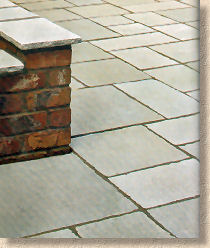
In the absence of any other contenders, it can only be assumed that the aforementioned Coach House Paving is the Big Secret with which we were mildly teased last autumn. If it is the Big Secret then it's something of an anti-climax, because there's nowt really new about it, which makes me think that the real Big Secret must be the Active Shield ™ jollop, because that is new, or new to Marshalls, at least.
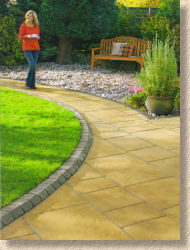
The Coach House paving is a better-than-average wet-cast concrete flagstone with a gently-weathered riven effect surface. The honeyed "Cotswold" colour is warm and probably a shade more yellow than genuine Ham stone. It is supplemented by a typical grey-green that's been named "Heathland" and a rather sombre dark-satanic-mills flavour that has been lumbered with the name "Pennant". 35mm thick, in potentially seven sizes that come in two project packs, except one pack contains only 4 sizes.
It's a better looking flag than Heritage, and very much in the vein of the excellent Chancery, but I can't figure out why launch a new range when Chancery does so well. The only real difference is this Active Shield ™ stuff, which is proclaimed as being exclusive to Coach House. Aaah! I think I know what's going on!
So: what is it with this Active Shield™ ? Some years ago, a canny entrepreneur chanced upon a liquid mono-fluoroethane and realised that it could be daubed over almost any permeable surface whereupon said surface would be reasonably well protected from stains, lichens, algae, chewing gum, burger fat and all sorts of other undesirables. It was just that mono-fluoroethane isn't what you'd call a 'snappy name'. Luckily, the chemistry behind this modern-day Philosopher's Stone is uncannily similar to that of Teflon™, a name that almost all of us will know from direct experience of frying bacon.
However, the market for paving sealants was limited. Getting the good folk of Britain and Ireland to pay more than 30 quid for a square metre of paving was hard enough without then seeking another fiver for a quality sealant! Luckily, the market has matured and many people are prepared to view their new patio as an investment, and an investment that needs protection. Enter stage right, the liquid Teflon™
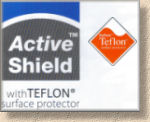
Marlux in that there Europe have been using a similar system for a few years, and Charcon have started using it with their StoneMaster paving range, so it was only a matter of time before Marshalls unveiled their own version. Unlike more normal sealants that tend to be applied onsite once installation is complete, the Active Shield™ (and other similar products) are applied during manufacture and shipped from the factory in a pre-treated manner, ready to be laid and exposed to everything the weather and a bunch of unruly kids can throw at it.
There's no doubt that the factory-applied sealants are a product whose time is about to come. The two biggest paving manufacturers in Britain have now committed to their use, so it can only be a matter of time before the rest follow suit. However, the real market for these 'wonder sealants' is with urban streetscapes. Imagine a sealant that will protect all that lovely granite and porphyry that's just been laid to the town centre from the indignities hurled upon it (literally!) each weekend by over-exuberant youths laden down with bottles of fizzy beer, pitta breads with mystery meat contents, and overstretched bladders. The ability to hose down all the filth and degradation (and to clean the pavements while they're at it!) makes this new generation of sealants an area of interest to many local highways departments.
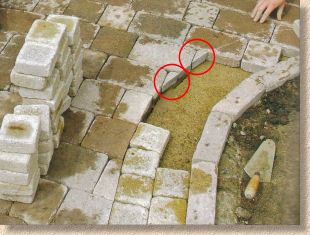
The Garden Paving section closes with yet another plug for the Approved Installers scheme, and it seems the installers featured in the main photo have been approved to install tiny triangular pieces of cut blocks that don't comply with BS7533:3 , the standard that covers the laying of block paving. No cut pieces less than a quarter of a block, says the official document. I doubt these farty little pieces meet that requirement! It doesn't engender confidence, I'm afraid.
I'm all in favour of having contractors vetted, but when workmanship doesn't meet the fairly simple requirements set out in the British Standards, you can't really claim the workmen are professional, and if this work meets the guidelines of the Approved Contractor Scheme, as claimed in the accompanying text, then those guidelines urgently need revising!
Nowt new in Paths and Edgings , and nowt in Garden Accessories , so straight on to pages 104-105 where the smorgasbord of walling products has been augmented by the appearance of Heritage Walling - well, it was only a matter of time, wasn't it? Heritage, as a paving range, has been around since the early 1990s, so the only real surprise is why it took so long to launch a complementary walling range.
Sadly, the world of wet-cast concrete has moved on quite a distance since those halcyon days when the government was held in utter contempt and Heritage was considered to be as good as it got, so when contrasted with modern young upstarts, such as the Coach House paving discussed above, both the colours and the surface texture looks dated to my eyes. I'm sure someone will give it a home, but in a market that has had its tastes carefully attuned to the delights of natural stone, this looks clumsy and so obviously false.
Five different sizes of three-faced blocks, in the two more popular Heritage colours of Calder Brown and Yorkstone, all topped off with a complementary coping that's even available in a radius version.
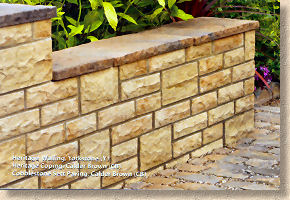
On to the Driveways section and, naturally, the big news here is the permeable paving nonsense churned out by our belaboured government last September and a source of massive indifference ever since. Once again, the concise advice on what is and what's not permissible is repeated, and once again it's not made clear that there are different requirements outside England.
The corner flash claiming these two pages comprise a "comprehensive guide" is fanciful to say the very least. Not one mention of gravel or spaced paving, but one helluva push for the various Priora flavours of concrete block permeable paving (CBPP) which is one of the more expensive options when looking to construct legislation-compliant front garden paving .
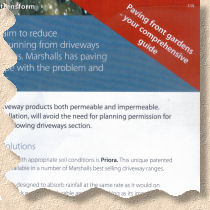
This annoys me. Marshalls did more than most last Autumn to draw attention to the new legislation, and they have every right to benefit from the enormous amount of work they put in at that time, but this 'featurette' is highly biased, it's simplistic and it borders on the misleading. There was good opportunity here to explain the full range of options available to homeowners, but instead, it is a massive plug for CBPP and gives the false impression that permeable block paving is the only viable option. Whatever option a householder chooses, whether it's permeable or impermeable, compliant or needing planning permission, there are Marshalls' products that can be used, so why distort the situation and give such a blatant push for CBPP?
In fact, there are only two new block paving products this year. That's not necessarily a bad thing: if it's not broke, don't fix it! The Marshalls' stable is nicely maturing and includes a commedably high proportion of winners. Yes; there's a donkey or two in there, but there isn't the space here to go into why Driveline Excel is a waste of good concrete. When you consider the studs that are nuzzling their impressive heads over the half-door, the likes of Driveline, Tegula and the superb Argent, you don't mind letting the donkey have the odd nibble on a carrot.
And it's Argent that has been given the honour of a new format: Argent Priora . The same old Argent that exudes class, style and sophistication, but now with added leaks!
Argent can do no wrong in my eyes, and having a permeable version just makes it all the more desirable. The only caveat, and I'm sure I've mentioned this before, is the use of the palest version, Argent Light, on driveways with sharp turning heads or channelised traffic. That wonderfully gritty surface is prone to tyre marks, so use it wisely, or get it sealed!
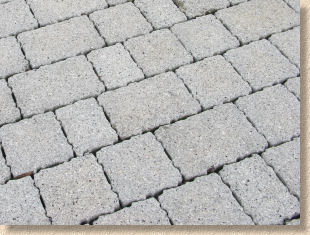
In the news feature that covered the press release last October, I predicted that Driveline 50 Vintage would be the most successful of the new products, and my opinion hasn't changed since then. This is just such an obvious idea: the shape and size of Driveline with the tumbled texture of Drivesett Tegula. It offers a much-needed intermediate between the modern 200x100 format and the olde-worlde tumbled rectangles.
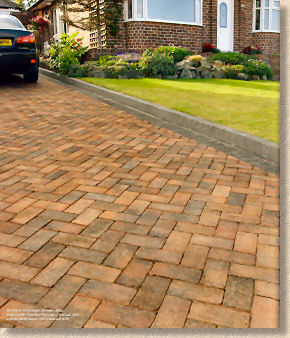
It's no surprise that the main photo used to promote the product features a fairly typical inter-war period detached house: too old and stylish for Driveline but a tad too modern for Drivesett Tegula. It just works so well!
Just three colours: Brindle (Red Multi), Burnt Ochre (Brown Multi) and Charcoal, and a standard 200x100x50mm format but they'll combine well with standard Driveline 50 or Drivesett Tegula as contrasting edge courses. You could even insert one of the Drivesett Tegula Circles or Octants to add interest to larger areas.
Price will be key in determining just how well this will sell, and the shocking variation in prices quoted to me so far is a little worrying. At 20 quid per square metre or less, it will do well, but the outlet that quoted me 36 quid either doesn't want to sell any or there's been a cock-up with their computer system, because we can get Drivesett Tegula for half that price.
And that's about it. The last few pages are given over to adverts for products from other Marshalls' companies, such as garages and greenhouses. There's another plug (yawn!) for the Approved Installers and the guarantee-that-you-pay-for scheme, and other than an unnecessarily complicated page about the use of the Priora paving products (I mean, who needs to know that the Acid-soluble sulphate content for laying aggregate must be AS 02 ?) there is no laying guidance, probably because that would conflict with the relentless push for the Approved Installers.
More than ever, this 2009 edition of the Marshalls' Brochure sits uneasily between being a traditional paving and hard-landscaping catalogue and a flick-through colour magazine that falls out of the Sunday papers. It never really makes up its mind as to which it wants to be. The information that is repeated over and over again, such as the plug for Approved Installers and the Front Garden Paving "guidance", contribute to that sense of reading a magazine rather than making a decision about paving. It may be me: maybe that's what was intended with all those pages about makeovers and lifestyle buzzwords, but I find it distracting and unnecessary.
And you can't help notice the carbon footprint thing stamped on every page, every product. While it's commendable that a company such as Marshalls has made such a commitment, the impact it will have on a customer's choice is negligible, bordering on non-existent. This website received over 60,000 emails about paving last year and not a single one of them questioned the carbon footprint of a hard-landscaping product. There were a good few about ethical sourcing of imported stone, an area in which Marshalls did lead the field, but rightly or wrongly, carbon footprints have little bearing on our lives in these straitened times and I can't believe that a customer would choose, say, Firedstone Paving over Natural Slate because it's roughly half the carbon footprint.

So for whose benefit are all these footprint symbols included: the customer's or the corporate social responsibility agenda?
It's also noticeable that there's no mention whatsoever of the Transformation Centres which are to be closed down, as announced last month . Given the timescale necessary to produce a brochure of this scale and quality, that decision must have been taken some while ago.
Without a doubt, almost every contractor in Britain will have a copy of the 2009 brochure in their van this year. It's one of the few 'essential publications' of our trade, and the actual paving content is excellent. The photography is high quality and the staging is quite aspirational, but not over-the-top. The descriptive text is cogent, relevant and useful, and thankfully avoids much of the flowery text that mars other brochures. The sizing and packaging information is perfectly presented in logical and tidy tables, and colour swatches are generally good. If only less space was wasted on waffle and the tiresome plugging of the Approved Installers.
You can pick up your copy of the 2009 brochure at your local stockist, order it online via Marshalls' website, or call their helpline on 0845 820 5000


